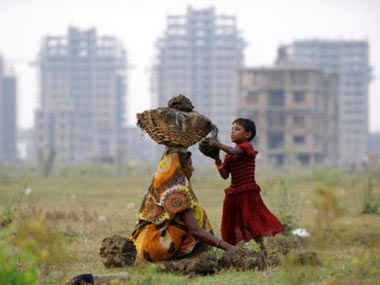India’s long term-growth story, driven by domestic consumption and a favourable demographic profile, could be undermined by the government’s failure to address excessive spending and the country’s weak fiscal position, says noted economist Jim Walker.
“We’re now in a world where budget deficits are going to be the focus of everybody’s attention, especially every rating agency and investor. And India is going in the wrong direction,” Walker told Firstpost in Hong Kong.
Blaming the government’s “incontinence” as regards fiscal spending, and for pursing entitlement programmes rather than a growth strategy, Walker pointed out that India was now experiencing an economic growth slowdown - and that “the effects of the bad decisions of the government are still to come through.”
Asked if the government’s inability or unwillingness to address near-term fiscal excesses could jeopardise India’s longer-term structural growth story, which he has in the past held up as a superior model than China’s, Walker said that that risk remained a possibility.
[caption id=“attachment_79711” align=“alignleft” width=“380” caption=“For India, it would be better to do the right thing early. AFP Photo”]
 [/caption]
[/caption]
“The less the government does now to address the fiscal position, the more it is going to be forced to do in the future - and perhaps at the wrong time. And that then will begin to undermine the potential from some of the good things that are happening in the Indian corporate sector,” Walker noted.
Then again, he added, “there’s another way of looking at it.” The worse things get right now, the more the government will be forced to do the right things in the future - and cut spending pretty dramatically. And that would be good news."
Even so, it would be better to do the right thing early, Walker said.
In his estimation, India’s real GDP growth would dip to below 7 percent in fiscal year 2012, and the central government budget deficit would rise from 4.8 percent to 6 percent, setting India back on the path to restoration of fiscal prudence. Rating agencies would likely put India on the watch list, he reckoned.
China model is failing
Walker’s view on China’s economy is even more dire - and at the heart of China’s problem, he says, is “mispricing of capital”, owing to artificially low interest rates, which is feeding malinvestments in the economy.
“China is so far behind the interest rate curve it’s not funny anymore, and the work that has to be done is monumental.”
Pointing to a “lot of pressures” within the Chinese economy, Walker says that China will have no policy response left in the event of a downturn in the global economy because its debt levels are too high as a result of what it’s done over the past three years.
Owing to capital mispricing, China is “taking more and more dollars to produce the same amount of growth.” And increasingly, much of the GDP growth is coming from unproductive investments.
Unlike in the 1990s and early 2000s when China invested in “productive investments”, today’s GDP growth is increasingly coming from building “houses and roads and statues and monuments to local governments.”
The problem with property investments, reasons Walker, is that it has no intrinsic return going forward. “You may be able to get a rental on it, but there is no guaranteed return coming through every month or year, which is what productive capacity offers.”
And unless China accelerates its already excessive money supply growth and fuels construction of even more empty houses, economic growth will have to slow down .
Continues on the next page
Why the Chinese yuan will not rule the world
Will the moves towards greater internalisation of the Chinese currency, the renminbi (or the yuan), accelerate its goal of becoming a global reserve currency? Walker is more than a little sceptical. “It first needs to become convertible, and we’re a long way away from that. So, it’ll take a long time.”
What was surprising, he noted, was that China was not internationalising its currency at great speed, despite all the hype surrounding its internationalisation.
Even the limited offering of renminbi-denominated bonds doesn’t amount to much because they aren’t being offered “on the basis that the renminbi can be used anywhere in the world, including China.” Such “fungibility” would signal that there is some seriousness about these bond issuances. Until that happens, he added, it’s more hype than reality.
Why QE3 is unlikely
Walker believes that US Fed Reserve Chairman will come under great political pressure not to implement a third round of monetary easing, although “conditions in the market right now and the increasing fragility of the US economy would argue for a QE3 in Bernanke’s mind.”
When he introduced QE2, the US inflation rate was below 2 percent, and core inflation rate was below 1 percent. “But today, the inflation rate is 3.6 percent and the core inflation rate is above the threshold of 2 percent.”
Increasingly, however, Bernanke will face a pushback from markets, which disbelieve him when he says that Quantitative Easing is not to blame for the rise in commodity prices.
“The ‘positive feature’ of QE2 was that equity prices rose for four months, with the risk trade back on,” noted Walker. “I would give QE3 just four days before markets absolutely tank.”
Venky Vembu attained his first Fifteen Minutes of Fame in 1984, on the threshold of his career, when paparazzi pictures of him with Maneka Gandhi were splashed in the world media under the mischievous tag ‘International Affairs’. But that’s a story he’s saving up for his memoirs… Over 25 years, Venky worked in The Indian Express, Frontline newsmagazine, Outlook Money and DNA, before joining FirstPost ahead of its launch. Additionally, he has been published, at various times, in, among other publications, The Times of India, Hindustan Times, Outlook, and Outlook Traveller.
)